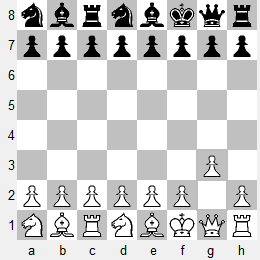The diagram shows the game after my opponent's first move 1.g3. At first I was puzzled by the move, but then realized that he intended to play the Queen to g2 and castle O-O as quickly as possible.
SP168 NBRNBKQR
After 1.g2-g3
While King safety is certainly important, the Kings are not in any particular danger here. I played 1...c5 with an eye on (1) development -- the move opens a diagonal for the Bb8, opens a file for the Rc8, and prepares ...Nc6 -- and on (2) the center, by staking a claim to d4. After the expected 2.Qg2, I continued 2...d5, opening a diagonal for the Be8 and staking a bigger claim to the center. Black's second move invites 3.Qxd5, but after 3...Bc6, I calculated that the complications were in Black's favor.
The game continued 3.O-O Nb6 4.c3. Since White's fourth move continued to ignore the center, I decided that it was already time to attack the castled King with 4...h5. After the further moves 5.h4 g5 6.hxg5 Qxg5, Black's attack is probably winning. By the time I castled O-O-O on the 11th move, all of my pieces were aimed at the White King. White resigned on the 18th move.
While castling is generally good, it's not always best, especially early in the game. It's primarily a defensive move, which renders it somewhat passive, and it fixes the position of the King as a target for the opponent's pieces. Its shortcomings were exemplified in this miniature.

No comments:
Post a Comment